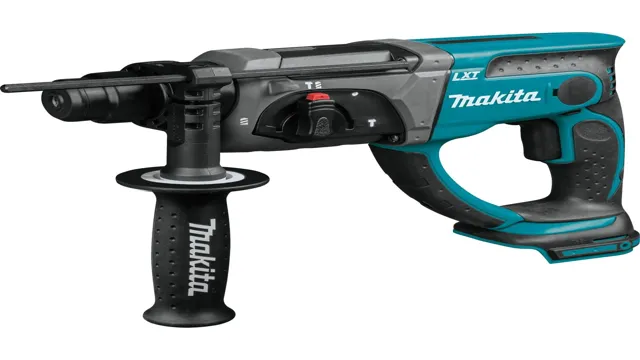
Traveling can be a stressful experience, especially when you have to pack various electronics and their batteries. If you’re planning to take your cordless drill battery on your trip, you may be wondering what you need to know before you go. Luckily, we’ve got you covered! In this blog post, we’ll discuss everything you need to know about traveling with cordless drill batteries, from their rules and regulations to their maintenance tips.
So, fasten your seatbelt and join us on this battery-powered journey.
Understanding Battery Regulations for Air Travel
If you’re a handyman looking to travel by air with your trusty cordless drill, you might be wondering if you’re allowed to bring the batteries onboard. The answer is yes, but with some restrictions. According to FAA regulations, lithium-ion batteries used for personal electronic devices are allowed to be carried in checked or carry-on bags, as long as they don’t exceed a certain watt-hour rating.
For cordless drill batteries specifically, the watt-hour rating must not exceed 100Wh, which is the equivalent to a 20-volt battery at 5Ah. It’s important to note that spare batteries should be properly packed and protected, with their terminals covered or taped to prevent short circuits. So, if you’re planning to travel with cordless drill batteries, make sure to check with your airline beforehand to ensure you’re within the acceptable limits.
FAA Guidelines
If you plan to travel with your drone, it’s essential to understand the FAA guidelines regulating battery use on airplanes. Lithium-ion batteries are categorized based on their watt-hour (Wh) ratings. Passengers are allowed to bring batteries with a rating of up to 100Wh for personal use on a plane.
However, batteries between 100Wh and 160Wh are only allowed with airline approval, and passengers are only permitted to bring two of these larger batteries. But batteries exceeding 160Wh are prohibited entirely, and special permission must be requested to bring them on board. It’s crucial to note that you must take measures to protect your batteries while traveling, such as ensuring they’re stored at an appropriate temperature and in carry-on luggage only.
Understanding these regulations can help ensure that both your batteries and you arrive safely at your destination.

TSA Guidelines
If you’re planning to travel by plane soon, understanding the TSA guidelines on batteries is critical. You’ll need to know what types of batteries are permitted in checked and carry-on luggage and how to pack them appropriately. Lithium-ion batteries are the most commonly used batteries in portable electronics, but they also pose significant safety risks.
As a result, the TSA has created regulations for batteries to ensure your safety and the safety of others on the plane. As a general rule, you should always pack spare batteries in your carry-on luggage to avoid having them confiscated at the security checkpoint. Additionally, batteries with a watt-hour rating of over 100Wh or 20,000mAh must be packed in your carry-on bag, and you can only bring two spare batteries with you on the plane.
Always double-check your airline’s specific guidelines for battery-powered devices, so you know what to expect before you arrive at the airport. Remember to pack carefully, and you’ll be well on your way to a hassle-free air travel experience.
Packing Cordless Drill Batteries for Safe Travel
If you’re wondering, “Can I travel with cordless drill batteries?” the short answer is yes, but you need to pack them properly to ensure your safety and the safety of those around you. First and foremost, be sure to check the airline’s specific rules and regulations regarding lithium-ion batteries, as each airline may have different restrictions. In general, it’s recommended to remove the battery from the drill and pack it in your carry-on luggage rather than your checked baggage.
You may also want to consider putting the battery in a protective case, such as those designed for camera batteries, to prevent damage or accidental activation. Safety should always come first, so take the time to pack your cordless drill batteries properly and avoid any potential mishaps during your travels.
Wrap the Battery Terminals
If you’re planning to take your cordless drill on a trip, it’s essential to pack your batteries safely. One of the key safety measures is to wrap the battery terminals. Terminal covers can prevent your batteries from contacting any metallic items in your luggage and cause a dangerous short circuit.
You can also use electrical or duct tape to wrap the terminals. Choose a high-quality tape with strong adhesion that won’t come loose during travel. Wrapping the terminals is a simple step that can help make sure your drill batteries stay protected during transit.
Remember, safety should always be a top priority when traveling with electrical equipment, so take the time to pack your batteries carefully and properly.
You May Also Love:
Use a Durable Carry-On Case
When it comes to traveling with cordless drill batteries, it’s essential to take the necessary precautions to ensure they arrive safely and undamaged. One way to do this is by investing in a durable carry-on case. Look for one that has a hard exterior shell and foam padding on the inside to protect your batteries from any bumps or drops during transit.
When packing your batteries, be sure to remove them from the drill and place them in a plastic bag before packing them in the case. This prevents any contact with other metal objects that could cause a short circuit. By taking these simple steps and utilizing a sturdy carry-on case, you can easily and safely bring your cordless drill batteries with you on your next trip.
Keep Batteries Separate from Tools
When traveling with cordless power tools, it’s crucial to keep the batteries separate from the tools themselves. Packing the batteries properly can help prevent accidents or damage to your tools. One of the most critical things to keep in mind is to remove any batteries from the tool and pack them in separate containers to avoid any accidental contact or short-circuiting.
You can use specialized battery cases or simply wrap them in a protective material, such as bubble wrap, to ensure they don’t get damaged or punctured during transport. It’s also essential to check with your airline about their regulations on packing and carrying batteries before you embark on your journey. By taking these precautions, you can ensure the safe transport of your cordless drill batteries and keep your tools in good working order.
Tips for Hassle-Free Travel with Cordless Drill Batteries
When it comes to traveling with cordless drill batteries, there are a few things to keep in mind to ensure a hassle-free experience. First and foremost, it’s important to confirm with your airline that they allow cordless drill batteries on board. Most airlines will allow the batteries as long as they are properly packed in your carry-on luggage and meet certain weight and size restrictions.
It’s also recommended to pack the batteries in their original packaging or specialized battery cases to avoid any potential hazards. Another tip to keep in mind is to make sure the batteries are fully charged and disconnected from any power tools during the flight. This will prevent any accidental activation or damage to the batteries.
By following these guidelines, you can travel with your cordless drill batteries with ease and peace of mind.
Check Airline Regulations Ahead of Time
If you plan on traveling with cordless drill batteries, it’s important to check airline regulations ahead of time. Different airlines have different rules and restrictions when it comes to batteries, so it’s important to do some research beforehand to avoid any issues at the airport. Most airlines will allow you to bring your drill batteries in your carry-on luggage, as long as they are properly packaged and meet the airline’s size and weight restrictions.
However, some airlines may require that you remove the batteries from your drill and pack them separately in a protective case. It’s also important to note that lithium-ion batteries, which are commonly used in cordless drills, are subject to certain restrictions due to their potential fire risk. So, make sure to familiarize yourself with the rules and regulations before heading to the airport to ensure a hassle-free travel experience with your cordless drill batteries.
Consider Shipping Batteries Ahead of Time
When you’re traveling with cordless drill batteries, it’s important to plan ahead to avoid any hassles or delays. One useful tip is to consider shipping the batteries ahead of time instead of carrying them in your carry-on or checked luggage. This can help you avoid any potential issues at security checkpoints or if your luggage is inspected.
However, it’s important to note that shipping batteries comes with its own set of regulations and restrictions, so be sure to check with your shipping provider and follow all necessary guidelines. Additionally, if you do choose to pack your batteries in your luggage, make sure they are properly stored and labeled to prevent any accidental damage or discharge. By taking a few extra precautions, you can ensure a smooth and stress-free travel experience with your cordless drill batteries.
Final Thoughts on Traveling with Cordless Drill Batteries
If you’re wondering whether you can travel with cordless drill batteries, the answer is yes, but you need to take some precautions. Many airlines and transportation authorities have regulations regarding the transportation of lithium-ion batteries, which are commonly used in cordless drill batteries. Before you travel, make sure to check with the airline you’ll be flying with to find out their specific policies.
In general, you’ll want to carry the batteries in your carry-on luggage, rather than in checked baggage, as this is generally safer and will help prevent damage to the batteries. You may also need to take steps to protect the battery terminals from damage or short-circuiting during transport. Overall, traveling with cordless drill batteries is usually safe and easy, as long as you do your homework and take appropriate precautions.
Conclusion
In the end, the answer to whether you can travel with cordless drill batteries is the age-old adage: it depends. While many airlines and transport authorities have restrictions that limit the type and quantity of batteries, you can often travel with cordless drill batteries as long as you pack them safely and follow the rules. So go ahead and bring your trusty power tool on your next adventure, but be sure to do your research beforehand and always carry the proper paperwork.
Happy travels (and DIY-ing)!”
FAQs
What are the restrictions on traveling with cordless drill batteries?
Lithium-ion batteries used in cordless drills are allowed to be transported in both checked and carry-on baggage, but they must be packed safely in their own individual protective case.
Can I bring spare cordless drill batteries on a flight?
Yes, you can bring spare lithium-ion batteries on a flight, but they must be packed in carry-on baggage, not in checked baggage.
How many cordless drill batteries can I bring on a plane?
The maximum number of spare lithium-ion batteries you can carry is two. If you have more batteries, you must declare them to the airline.
What should I do to pack my cordless drill batteries safely?
To pack your cordless drill batteries safely, use their original packaging or wrap them in a plastic bag or tape over the terminals to avoid short-circuiting.
Can I use my cordless drill batteries on the plane?
You cannot use your cordless drill batteries on the plane, and the battery must be removed from the drill before boarding.
Do cordless drill batteries need to be at a certain charge level before traveling?
Cordless drill batteries should be at a charge level of less than 30%, according to TSA regulations.
Are there any special precautions I need to take while traveling with my cordless drill batteries?
Always carry your batteries in your carry-on baggage, keep them away from metal objects, and never carry damaged or swollen batteries on the plane.






